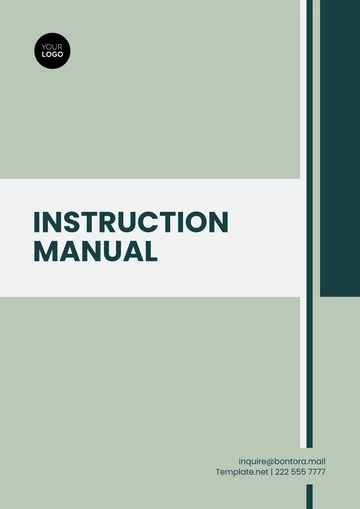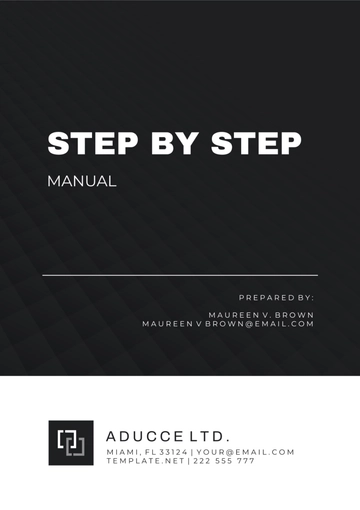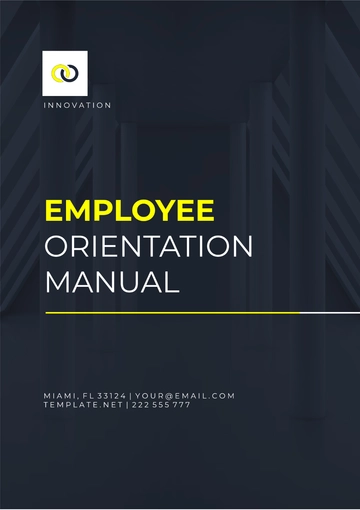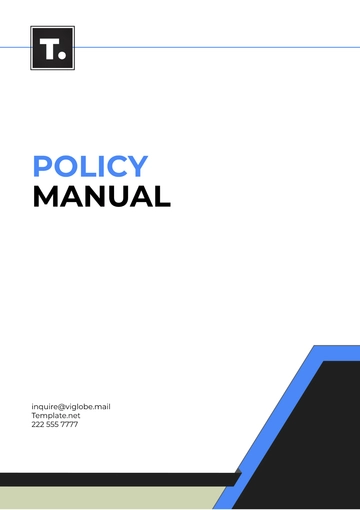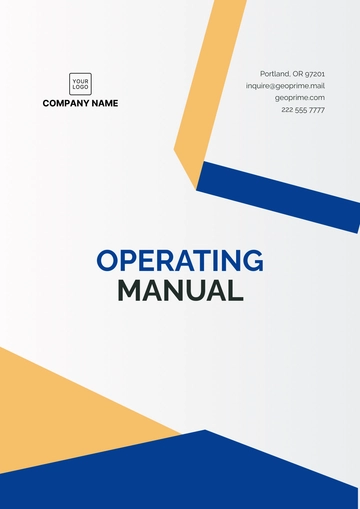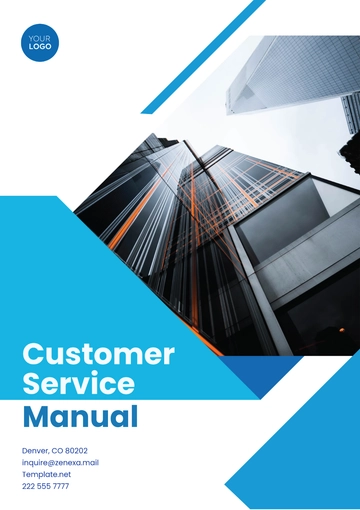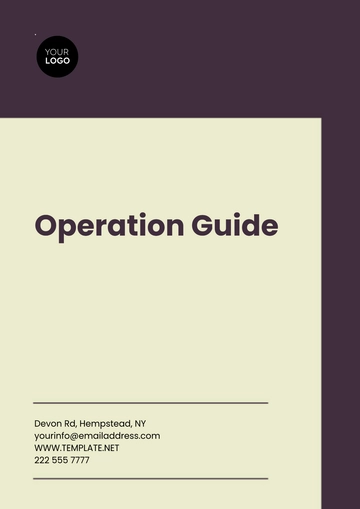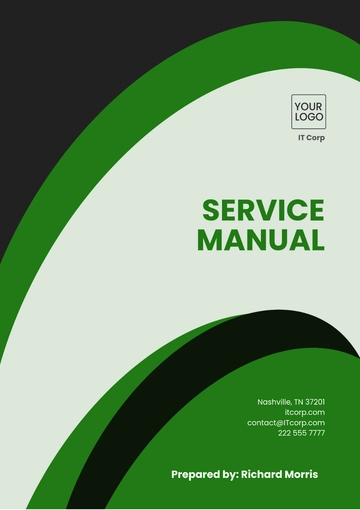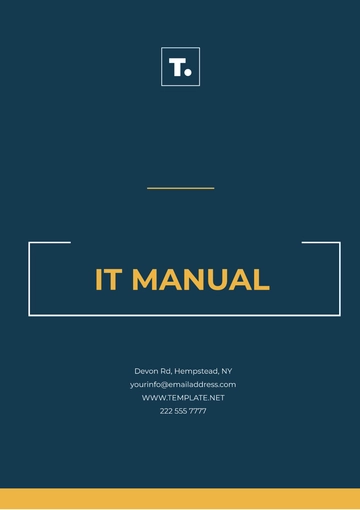Free Marketing Digital Training Manual
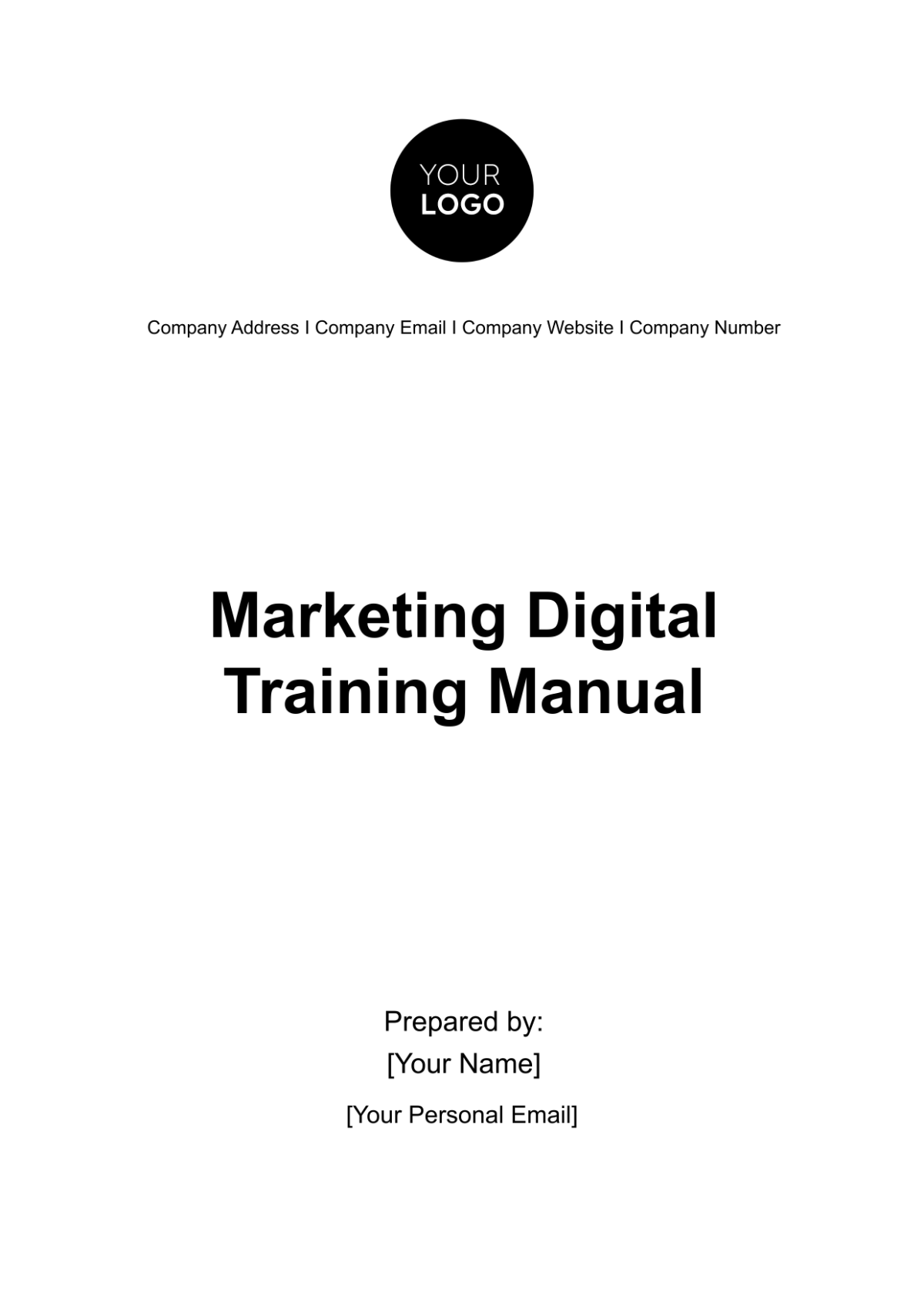
Date Created: January 1, 2050 Manual Version: 1.0
I. INTRODUCTION TO DIGITAL MARKETING
A. What is Digital Marketing?
Digital marketing encompasses a broad spectrum of online activities aimed at promoting products, services, or brands. It leverages digital channels and technologies to connect with target audiences, build brand awareness, and drive engagement and conversions.
B. The Importance of Digital Marketing
In the digital age, consumers are more connected than ever before. They browse, shop, and seek information online, making the digital sphere an indispensable arena for businesses. Here's why digital marketing is crucial:
Wider Reach: Digital marketing allows you to reach a global audience, breaking down geographical barriers.
Targeted Marketing: With precise data and analytics, you can tailor your marketing efforts to specific demographics, ensuring your message resonates with the right people.
Cost-Effective: Compared to traditional marketing, digital marketing often offers a more cost-effective way to achieve your marketing goals.
Real-time Engagement: Interact with your audience in real time, whether it's through social media, email, or instant messaging.
Measurable Results: Digital marketing provides robust analytics, allowing you to track and measure the performance of your campaigns, enabling data-driven decision-making.
C. Objectives of this Training
Throughout this training manual, our aim is to equip you with the knowledge and skills needed to excel in the digital marketing landscape. By the end of this training, you will:
Understand the fundamentals of digital marketing and its various channels.
Be able to create and implement effective digital marketing strategies tailored to your business goals.
Know how to leverage data and analytics for continuous improvement.
Stay informed about emerging trends and technologies in digital marketing.
II. DIGITAL MARKETING FUNDAMENTALS
A. The Digital Marketing Landscape
Digital marketing encompasses an array of channels and strategies, including but not limited to search engine marketing, content marketing, social media marketing, email marketing, and more. Understanding this vast landscape is crucial to making informed decisions about which channels are most effective for your business.
B. Key Digital Marketing Channels
Each digital marketing channel has its unique characteristics and advantages. In this section, we will explore the major channels in detail, shedding light on how they work and when to use them strategically to achieve your business objectives.
C. Understanding Your Target Audience
Successful digital marketing hinges on knowing your audience inside and out. We will delve into the process of creating detailed buyer personas, identifying customer pain points, and tailoring your marketing efforts to resonate with your target demographic.
III. WEBSITE OPTIMIZATION
Creating a User-Friendly Website
A user-friendly website is essential for a positive user experience. It should be easy to navigate, visually appealing, and responsive on all devices. Consider these best practices:
ASPECT | DESCRIPTION |
Mobile Optimization | Currently, over 70% of web traffic comes from mobile devices. Ensure your website is mobile-friendly, with responsive design and fast loading times. |
Intuitive Navigation | Implement clear and logical site navigation with organized menus and a user-friendly search function. Example: Amazon's website provides an intuitive menu and search bar for easy product discovery. |
Page Speed | Google's algorithms prioritize fast-loading websites. Optimize images, minimize code, and use content delivery networks (CDNs) to improve loading times. |
Accessibility | Ensure your website is accessible to all users, including those with disabilities. Use alt text for images and provide keyboard navigation options. |
Search Engine Optimization (SEO)
SEO is crucial for organic visibility in search engines like Google. Here are some key SEO strategies:
STRATEGY | DESCRIPTION |
Keyword Research | Use tools like Google Keyword Planner to identify relevant keywords for your industry. For example, if you're in the fitness industry, "best home workouts" might be a target keyword. |
On-Page Optimization | Optimize your website's meta titles, descriptions, and headers with target keywords. Example: If you run a bakery, optimize your "Wedding Cake" page with relevant keywords. |
Quality Content | Create high-quality, informative content that provides value to users. For instance, a real estate agency could create blog posts about "Buying a Home in Ohio." |
Backlinks | Build a network of quality backlinks from authoritative websites. Example: A tech startup might get a backlink from a reputable tech news site by contributing a guest post. |
IV. CONTENT MARKETING
Crafting Compelling Content
Compelling content engages your audience and drives them to take action. Some content types include:
Blog Posts: Regularly publish informative and entertaining blog posts. Example: A travel agency can create a blog post titled "Top 10 Must-Visit Destinations in 2050”.
Videos: Video content is highly engaging. Consider creating product demos, how-to guides, or behind-the-scenes videos. Example: A cooking school could produce video recipes.
Infographics: Visual content like infographics can convey complex information in an easy-to-digest format. Example: A finance company might create an infographic on "Investment Strategies for the 2050s."
Ebooks and Whitepapers: These longer-form pieces can establish your authority in the industry. For instance, a software company might offer an ebook on "Future Trends in Tech."
Content Distribution Strategies
Creating great content is only half the battle; you also need effective distribution. Consider these distribution strategies:
STRATEGY | DESCRIPTION |
Social Media | Share your content on platforms like Facebook, Twitter, and LinkedIn. Example: An eco-friendly product company can post a blog on "Sustainable Living" on their social media channels. |
Email Marketing | Send out newsletters with links to your latest content. Example: A fashion brand can send an email showcasing their new arrivals and linking to relevant blog posts. |
Guest Posting | Write guest posts for industry-related websites and include a link back to your content. Example: A fitness trainer can write a guest post for a health and wellness blog. |
Paid Promotion | Use paid advertising on platforms like Google Ads or Facebook Ads to boost content visibility. For instance, a tech startup might run a Facebook ad promoting their ebook on "AI Trends in 2050." |
V. SOCIAL MEDIA MARKETING
A. Building a Strong Social Media Presence
Choose the Right Platforms: Identify social media platforms that align with your target audience. For instance, if you're in the fashion industry, platforms like Instagram and Pinterest may be ideal.
Consistent Branding: Maintain a consistent brand image across all social media profiles, including profile pictures, cover photos, and bios.
Engaging Content: Share valuable and engaging content, such as posts, videos, and stories, to keep your audience interested.
Example: [Your Company Name] increased its Instagram engagement by 40% by regularly posting behind-the-scenes content, user-generated content, and product highlights.
B. Social Media Advertising
Targeted Ads: Utilize advanced targeting options on platforms like Facebook and LinkedIn to reach your desired audience based on demographics, interests, and behaviors.
Ad Formats: Experiment with various ad formats, such as carousel ads, video ads, and sponsored posts, to find what resonates best with your audience.
Budget Management: Set a clear advertising budget and monitor ad performance to optimize spending.
Example: [Your Company Name] achieved a 25% increase in website traffic through a well-targeted Facebook advertising campaign promoting their new product line.
C. Social Media Analytics and Insights
Metrics Tracking: Monitor key metrics like reach, engagement, click-through rates, and conversion rates to gauge the effectiveness of your social media efforts.
Social Listening: Use social media listening tools to gather insights from customer feedback and conversations, enabling you to adapt your strategy.
Competitive Analysis: Analyze competitors' social media activities to identify opportunities and areas for improvement.
Example: [Your Company Name] utilized social media listening tools to identify emerging trends and customer sentiments, leading to a successful product redesign that aligned with market demands.
VI. EMAIL MARKETING
A. Building Email Lists
Opt-in Forms: Implement opt-in forms on your website and landing pages to collect email addresses from interested visitors.
Segmentation: Segment your email list based on factors like demographics, purchase history, and engagement to send personalized content.
Incentives: Offer incentives such as discounts or exclusive content to encourage people to subscribe to your emails.
B. Effective Email Campaigns
Drip Campaigns: Create automated drip campaigns that deliver a series of emails over time, nurturing leads and guiding them through the sales funnel.
Personalization: Craft personalized email subject lines and content to increase open rates and click-through rates.
A/B Testing: Conduct A/B tests on different elements of your emails (e.g., subject lines, images, CTAs) to optimize performance.
C. Email Marketing Best Practices
Compliance: Ensure that your email campaigns comply with relevant laws, such as CAN-SPAM or GDPR, to avoid legal issues.
Mobile Optimization: Design mobile-responsive emails to cater to users who access emails on smartphones and tablets.
Analytics and Reporting: Monitor email campaign performance with metrics like open rates, click rates, and conversion rates, then use these insights to refine future campaigns.
VII. PAY-PER-CLICK (PPC) ADVERTISING
Understanding PPC Advertising
PPC advertising is a paid online advertising model where advertisers pay a fee each time their ad is clicked. It's a powerful way to drive targeted traffic to your website. Here are some key elements of PPC advertising:
ELEMENT | DESCRIPTION |
Keywords | Identify relevant keywords that potential customers might use when searching for your products or services. For instance, if you're a fitness equipment retailer, keywords like "treadmill for sale" or "home gym equipment" are relevant. |
Ad Auction | Search engines like Google and Bing hold ad auctions whenever someone performs a search. Advertisers bid on keywords, and the search engine determines which ads to display based on bid amount, ad relevance, and quality score. |
Ad Creatives | Create compelling ad copy and visuals that resonate with your target audience. Include a clear call to action (CTA) and highlight unique selling points. For example, an ad for a travel agency might promote "Exclusive 50% Off Vacation Packages." |
Google Ads and Bing Ads
Google Ads and Bing Ads are two prominent platforms for PPC advertising:
Google Ads: With Google Ads, you can display your ads on Google's search engine and its partner websites. It offers various ad formats, including text ads, display ads, and video ads. For instance, if you run a bakery, you can create a Google Ads campaign to appear when users search for "best local bakeries."
Bing Ads: Bing Ads, operated by Microsoft, allows you to reach a different audience. It's particularly valuable if your target demographic uses Bing as their primary search engine. Similar to Google Ads, you can create text, display, and video ads to promote your products or services.
VIII. DISPLAY ADVERTISING AND REMARKETING
A. Display Advertising Basics
Display advertising involves placing visual ads, such as banners or interactive media, on websites, apps, or social media platforms to reach a broader audience. Remarketing, a subset of display advertising, targets users who have previously visited your website. Here are key concepts:
Banner Ads: These are image or multimedia ads displayed on websites. For example, an e-commerce site may run banner ads featuring their latest products on popular fashion blogs.
Ad Networks: Advertisers can choose from various ad networks, like Google Display Network (GDN) or Facebook Audience Network, to distribute their display ads to a wide range of websites and apps.
Remarketing: When users visit your website and leave without making a purchase, remarketing allows you to show them relevant ads on other sites they visit. For instance, if a user looked at a specific pair of shoes on your online store but didn't buy them, you can retarget them with an ad displaying those shoes.
B. Remarketing Strategies
Remarketing can significantly improve conversion rates. Here are a few strategies and examples:
Abandoned Cart Remarketing: If an online shopper adds products to their cart but doesn't complete the purchase, you can use display ads to remind them of the items they left behind and offer incentives like discounts or free shipping.
Website Engagement Remarketing: Target users who visited specific pages on your website, such as blog posts or product categories. For example, if a visitor browsed your travel blog, show them ads promoting your vacation packages.
Dynamic Remarketing: Display ads featuring products or services that users viewed on your website. If someone explored different camera models on your electronics store, dynamic remarketing displays those exact camera models in the ads.
IX. INFLUENCER MARKETING
A. Leveraging Influencers for Brand Growth
Influencer marketing is a powerful strategy for expanding your brand's reach and credibility. Influencers are individuals who have established a significant following and influence in a particular niche or industry. Here's how to effectively leverage influencer marketing:
Identify Your Influencer Goals: Determine what you aim to achieve through influencer collaborations. Whether it's increasing brand awareness, driving sales, or improving engagement, align your goals with the right influencers.
Research and Selection: Thoroughly research potential influencers in your industry. Assess their authenticity, engagement rates, and audience demographics to ensure alignment with your target market.
Partnership Strategy: Develop a clear partnership strategy, including compensation, content expectations, and campaign timelines. Effective communication and mutual understanding are key to successful collaborations.
B. Identifying the Right Influencers
Identifying the right influencers for your brand requires careful consideration. Here's how to find and assess potential influencers:
Relevance: Choose influencers whose niche aligns with your product or service. The more relevant they are to your industry, the more impact they'll have on your target audience.
Audience Reach and Engagement: Evaluate an influencer's reach (number of followers) and engagement (likes, comments, shares). High numbers don't always guarantee influence; genuine engagement is vital.
Content Quality: Analyze the quality and consistency of an influencer's content. Look for a style that resonates with your brand's image and values.
B. Managing Influencer Campaigns
Effective management of influencer campaigns is essential for achieving your marketing goals:
Content Collaboration: Work closely with influencers to create content that aligns with your brand message and goals. Maintain transparency and provide guidelines while allowing creativity.
Monitoring and Metrics: Track campaign performance using key metrics such as reach, engagement, and conversions. This data will help you assess the success of your influencer partnerships.
Compensation and Contracts: Ensure that compensation agreements and contracts are well-defined and legally sound. Clarity regarding deliverables and payment schedules is crucial.
X. DATA ANALYTICS AND REPORTING
A. Data-driven Decision Making
In the digital marketing landscape, data is your compass. Effective data analysis allows you to make informed decisions and optimize your marketing strategies:
Data Collection: Use various analytics tools to collect data from your digital marketing channels, such as website traffic, social media engagement, and email click-through rates.
Data Interpretation: Analyze the data to identify trends, customer behavior, and areas for improvement. Pay attention to patterns and correlations that can inform your marketing efforts.
A/B Testing: Implement A/B tests to compare different marketing strategies and determine which ones yield the best results. This iterative approach helps refine your campaigns.
B. Key Digital Marketing Metrics
Understanding and monitoring key metrics is vital for assessing the effectiveness of your digital marketing efforts:
Conversion Rate: Measure the percentage of website visitors who take a desired action, such as making a purchase or signing up for a newsletter.
Click-Through Rate (CTR): Calculate the ratio of clicks on a specific link or ad to the number of times it was shown. CTR helps evaluate the effectiveness of your ads.
Return on Investment (ROI): Assess the profitability of your marketing campaigns by comparing the revenue generated to the cost of marketing.
C. Reporting Tools and Dashboards
Utilize reporting tools and dashboards to streamline data analysis and reporting:
Google Analytics: Google Analytics provides in-depth insights into website traffic, user behavior, and conversions. Customize reports to focus on your specific KPIs.
Social Media Insights: Platforms like Facebook, Twitter, and Instagram offer built-in analytics tools that provide data on audience demographics, engagement, and reach.
Marketing Automation Software: Invest in marketing automation tools that offer robust reporting and analytics features. These platforms can centralize data from multiple channels.
XI. CONCLUSION
A. Recap of Key Learnings: Throughout this comprehensive training manual, you've gained valuable insights into the dynamic world of digital marketing. We've covered essential topics such as website optimization, content marketing, social media strategy, email campaigns, paid advertising, and more. Take a moment to reflect on the key takeaways from each section and how they apply to your business.
B. Next Steps in Your Digital Marketing Journey: Your journey in digital marketing doesn't end here. To stay competitive and achieve long-term success, consider the following steps:
Continuously update your knowledge: The digital landscape evolves rapidly. Stay informed about the latest trends, tools, and technologies by attending webinars, conferences, and industry events.
Develop a customized strategy: Apply the knowledge you've gained to create a digital marketing strategy tailored to your business goals and target audience.
Experiment and iterate: Digital marketing is about experimentation and refinement. Don't be afraid to test new strategies and adapt based on data and insights.
C. Resources and Further Reading: To further enhance your digital marketing knowledge, we recommend exploring the following resources:
Online courses and certifications: Consider enrolling in digital marketing courses offered by reputable institutions and platforms.
Books and publications: Explore books written by industry experts and journals that cover the latest marketing trends and research.
Blogs and websites: Follow blogs and websites dedicated to digital marketing, where you can find valuable articles, case studies, and insights.
Online communities: Join digital marketing forums and social media groups to connect with fellow marketers and share experiences and knowledge.
Disclaimer: This training manual is intended for educational purposes and is not a substitute for professional marketing advice. [Your Company Name] disclaims any liability for actions taken based on the information provided in this manual.
© 2050 [Your Company Name]. All rights reserved.
- 100% Customizable, free editor
- Access 1 Million+ Templates, photo’s & graphics
- Download or share as a template
- Click and replace photos, graphics, text, backgrounds
- Resize, crop, AI write & more
- Access advanced editor
Unlock digital marketing success with our comprehensive Marketing Digital Training Manual Template. Stay ahead of the curve by mastering key strategies and techniques. Tailored for businesses of all types, this guide empowers you to thrive in the ever-evolving digital landscape. Get started on your path to digital marketing excellence today with our user-friendly product!
